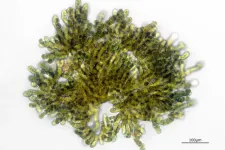(Press-News.org)
The Keck School of Medicine of USC has received funding from the National Institutes of Health as part of a five-year, $50.3 million “multi-omics” study of human health and disease involving six sites. Researchers in the Multi-Omics for Health and Disease consortium will study fatty liver disease, hepatocellular carcinoma, asthma, chronic kidney disease, preeclampsia and other conditions, with a focus on underrepresented racial and ethnic groups.
Throughout the study, researchers will use cutting-edge methods to collect a variety of biological data—including genomics, epigenomics, and transcriptomics—as well as information on patients’ social and environmental circumstances. By combining these datasets over the study period, the consortium aims to answer key questions about the cause of various diseases, as well as develop new tools for diagnosis and treatment. The Keck School of Medicine group will focus primarily on Hispanic patients, ages nine to 18, with non-alcoholic fatty liver disease (NAFLD).
“This is a silent epidemic,” said Vaia Lida Chatzi, MD, PhD, a professor of population and public health sciences at the Keck School of Medicine and one of the consortium’s principal investigators. “NAFLD usually causes no symptoms. Once children go to the doctor, they may already have damage to the liver.”
For that reason, it’s critical to learn more about the condition’s basis, as well as ways to prevent it, said Max Aung, PhD, an assistant professor of population and public health sciences at the Keck School of Medicine and a principal investigator for the consortium. Already the most common liver disease, NAFLD is on the rise among both Hispanic Americans and in children.
“We're conducting the first and largest longitudinal study of pediatric NAFLD and at the same time, we’re studying a population that has been historically neglected in biomedical research,” Aung said.
The power of multi-omics
To date, most longitudinal studies of human disease have tracked a single type of “omics” data, such as genomics (DNA), transcriptomics (RNA), epigenomics (chemical modifications that affect DNA function), proteomics (proteins that can affect cell function) or metabolomics (other molecules involved in cellular metabolism). But that approach can miss key relationships between various “omics” data, such as how changes in DNA relate to levels of various cellular proteins.
“By having all of this information available in the same dataset, we can learn more about biological mechanisms, and improve our ability to find biomarkers to use in the clinic,” Aung said.
NAFLD is typically diagnosed through a combination of enzyme testing and imaging, which can be expensive and may delay detection of the condition in some populations. Finding a reliable marker of the disease that can be detected in blood samples could help patients get treatment sooner, Chatzi said.
“If we have biomarkers that can be validated, that will be really useful for clinicians, both for early diagnosis and for evaluating the severity of the disease as it progresses,” she said.
Social and environmental factors
In addition to studying the biological basis of various diseases, researchers in the consortium will collect data on social and environmental factors that may help explain why some populations face a heightened risk. For example, the Keck School of Medicine team is collaborating with Sonoma Technology to estimate air pollution exposure across time and space for each patient they recruit.
Aung and Chatzi are also collaborating with the Southern California Center for Latino Health on a community engagement strategy that will involve recruitment of a community advisory board and development of a communication strategy for disseminating research findings to participants, as well as their families and communities.
The research team will begin recruitment in the fall, following a consortium-wide meeting to develop the scientific agenda for the next five years. In addition to specific disease insights, the team aims to develop research methods and analytic techniques that can be used in future longitudinal studies of multi-omics data.
“Multi-omics is the frontier of biomedical and environmental health research, and our team at USC is committed to advancing the best available science and methods to pursue this,” Aung said.
About this research
In addition to USC, the consortium’s other study sites are the University of California, San Diego; the University of California, San Francisco; Columbia University; the University of Illinois Chicago; and the University of Texas Health Science Center.
This work is jointly supported by National Human Genome Research Institute, the National Cancer Institute and the National Institute of Environmental Health Sciences.
END
Deep inside our cells—each one complete with an identical set of genes—a molecular machine known as PRC2 plays a critical role in determining which cells become heart cells, versus brain or muscle or skin cells.
When the machine is missing or broken, normal fetal development can’t occur. If it’s mutated, cells can grow uncontrollably, and cancer can arise—a fact that has made PRC2 a source of keen interest for drug developers.
New research by scientists at CU Boulder and Harvard Medical School offers an unprecedented ...
The vagus nerve, known for its role in ‘resting and digesting’, has now been found to have an important role in exercise, helping the heart pump blood, which delivers oxygen around the body.
Currently, exercise science holds that the ‘fight or flight’ (sympathetic) nervous system is active during exercise, helping the heart beat harder, and the ‘rest and digest’ (parasympathetic) nervous system is lowered or inactive. However, University of Auckland physiology Associate Professor Rohit Ramchandra says that this current understanding is based on indirect estimates and a number of assumptions their new study has ...
Peer reviewed / Review, analysis and opinion
Cancer is a leading cause of mortality in women and ranks in the top three causes of premature death (under age 70) in women in almost every country worldwide.
New analysis finds, of the 2.3 million women who die prematurely from cancer each year, 1.5 million lives could be saved through the elimination of exposures to key risk factors or via early detection and diagnosis, while a further 800 000 deaths could be prevented if all women could access optimal ...
The estimated prevalence of REDs varies by sport, ranging from 15% to 80%. The syndrome often goes unrecognised by athletes themselves, their coaches, and team clinicians, and may unwittingly be exacerbated by the ‘sports culture,’ because of the perceived short term gains on performance from intentionally or unintentionally limiting calorie intake, warns the Statement.
REDs was first recognised as a distinct entity by the IOC in a 2014 consensus statement. This latest consensus, informed by a panel of international experts, draws on key advances in REDs science ...
Policies designed to reduce greenhouse gas emissions have been effective, however more stringent regulations are needed to limit global warming to the Paris temperature goals, finds a new analysis by UCL researchers of international efforts to fight climate change.
The research, published in Annual Reviews of Environment and Resources, tracked the rate of greenhouse gas emissions over the last two decades against global efforts to reduce them. Since the early 2000s, governments around the world have enacted numerous regulations to curb greenhouse gas emissions. Over the same ...
Before SARS-CoV-2 and the COVID-19 pandemic, there was the Zika virus epidemic, lasting from 2015 to 2016. The Zika virus can cause serious birth defects and abnormalities. During the epidemic, one of the most striking results of Zika virus in pregnant women was the increase in offspring with microcephaly or a head much smaller than expected, a condition that can result in abnormal brain development.
While the Zika virus epidemic has ended, future outbreaks are inevitable as most of the world’s population lives in areas where the Zika virus mosquito thrives. Researchers in the Aagaard Lab at Baylor College of Medicine ...
The cyanobacterium Aetokthonos hydrillicola produces not just one, but two highly potent toxins. In the latest issue of the journal Proceedings of the National Academy of Sciences (PNAS), an international team led by Martin Luther University Halle-Wittenberg (MLU) and Freie Universität Berlin describes the second toxin, which had remained elusive until now. Even in low concentrations, it can destroy cells and is similar to substances currently used in cancer treatment. Two years ago, the same team established that the first toxin from the cyanobacterium is the cause of a mysterious disease among bald eagles in the USA.
Aetokthonos hydrillicola is ...
BUFFALO, N.Y. – Just about everyone knows that cigarette smoke is bad for babies. Should cooking fuels like natural gas, propane and wood be viewed similarly when used indoors?
That’s the takeaway from a new study led by University at Buffalo researchers, who looked at indoor air pollution exposure and early childhood development in a sample of more than 4,000 mother-child pairs in the U.S.
“Exposure to unclean cooking fuel and passive smoke during pregnancy and in early life are associated with developmental delays in ...
A University of Texas at Arlington researcher is working with a not-for-profit cooperative to develop and test a smart, automated cart that could replace humans who conduct fire hazard safety checks in nuclear power facilities.
Chan Kan, a UT Arlington assistant professor in the Department of Industrial, Manufacturing and Systems Engineering (IMSE), will lead the $250,000 project with the cooperative Utilities Service Alliance.
“We will develop and build a cart with state-of-the-art equipment that could replace human testing of nuclear facilities,” Kan said.
Currently, when the primary fire-sensing system fails or ...
The complex relationship between physical activity and energy balance – food intake versus energy expenditure – is still a challenge for science, especially in light of the rising worldwide prevalence of overweight and obesity. Some of the medications available on the market to combat obesity work analogously to hormones associated with appetite control, and for some time researchers have focused on understanding how processes involving metabolites (products of cell metabolism) affect hunger and satiety.
A ...



